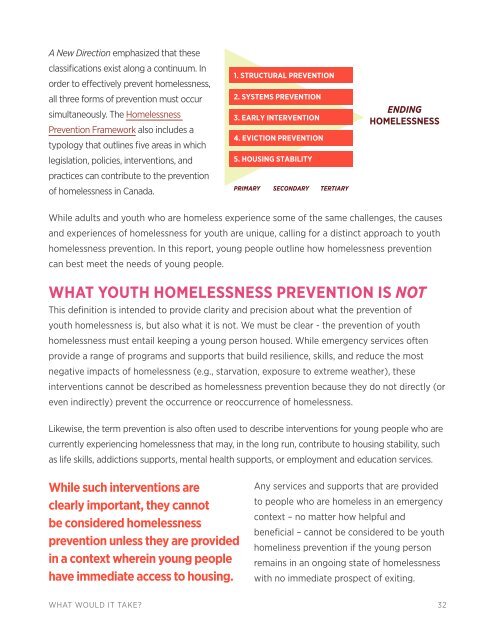COH-AWH-What_Would_it_Take
Create successful ePaper yourself
Turn your PDF publications into a flip-book with our unique Google optimized e-Paper software.
A New Direction emphasized that these<br />
classifications exist along a continuum. In<br />
order to effectively prevent homelessness,<br />
all three forms of prevention must occur<br />
simultaneously. The Homelessness<br />
Prevention Framework also includes a<br />
typology that outlines five areas in which<br />
legislation, policies, interventions, and<br />
practices can contribute to the prevention<br />
of homelessness in Canada.<br />
1. STRUCTURAL PREVENTION<br />
2. SYSTEMS PREVENTION<br />
3. EARLY INTERVENTION<br />
4. EVICTION PREVENTION<br />
5. HOUSING STABILITY<br />
PRIMARY SECONDARY TERTIARY<br />
ENDING<br />
HOMELESSNESS<br />
While adults and youth who are homeless experience some of the same challenges, the causes<br />
and experiences of homelessness for youth are unique, calling for a distinct approach to youth<br />
homelessness prevention. In this report, young people outline how homelessness prevention<br />
can best meet the needs of young people.<br />
WHAT YOUTH HOMELESSNESS PREVENTION IS NOT<br />
This defin<strong>it</strong>ion is intended to provide clar<strong>it</strong>y and precision about what the prevention of<br />
youth homelessness is, but also what <strong>it</strong> is not. We must be clear - the prevention of youth<br />
homelessness must entail keeping a young person housed. While emergency services often<br />
provide a range of programs and supports that build resilience, skills, and reduce the most<br />
negative impacts of homelessness (e.g., starvation, exposure to extreme weather), these<br />
interventions cannot be described as homelessness prevention because they do not directly (or<br />
even indirectly) prevent the occurrence or reoccurrence of homelessness.<br />
Likewise, the term prevention is also often used to describe interventions for young people who are<br />
currently experiencing homelessness that may, in the long run, contribute to housing stabil<strong>it</strong>y, such<br />
as life skills, addictions supports, mental health supports, or employment and education services.<br />
While such interventions are<br />
clearly important, they cannot<br />
be considered homelessness<br />
prevention unless they are provided<br />
in a context wherein young people<br />
have immediate access to housing.<br />
Any services and supports that are provided<br />
to people who are homeless in an emergency<br />
context – no matter how helpful and<br />
beneficial – cannot be considered to be youth<br />
homeliness prevention if the young person<br />
remains in an ongoing state of homelessness<br />
w<strong>it</strong>h no immediate prospect of ex<strong>it</strong>ing.<br />
WHAT WOULD IT TAKE? 32
















